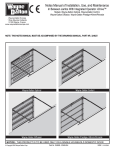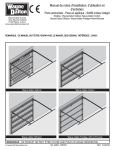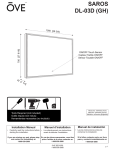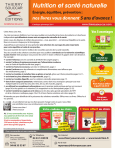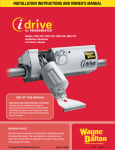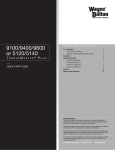Download To - Garage Doors
Transcript
Notes Manual of Installation, Use, and Maintenance Behind Jambs Without Integrated Operator Models: Wayne-Dalton Optimal, Wayne-Dalton Confort, Wayne-Dalton Diffusion, Wayne-Dalton Prestige+/40mm/Pinnacle Wayne-Dalton Europe 1 Rue Maurice Hollande 51100 Reims, France www.waynedaltoneurope.com NOTE: THIS NOTES MANUAL MUST BE ACCOMPANIED BY THE DRAWINGS MANUAL, PART NR. 324621. NOTICE : THIS PRODUCT IS TO BE USED ONLY ON A SINGLE HOUSEHOLD DOMESTIC DOOR © Copyright 2007 Wayne-Dalton Corp. Part Nr. 324622 - ENGLISH REV2 04/06/2007 TABLE OF CONTENTS Notes of Installation, Use, and Maintenance Definition Of Symbols ..................................................................................................................................................... 3. Important Safety Instructions For Installation .................................................................................................................. 3. Package Contents ........................................................................................................................................................... 4. Required Tools ................................................................................................................................................................ 4. “INSTALLATION” Door Assembly Mounting .......................................................................................................................................... 5. Horizontal Track Mounting ........................................................................................................................................ 5. Spreader Bar Pre-mounting ...................................................................................................................................... 6. Back Hanging Horizontal Track, Spreader Bar And Manual Door Testing ............................................................... 6. Striker Plate Mounting (If required) ........................................................................................................................... 7. CE / Serial Number Label ......................................................................................................................................... 7. Spring Adjustments (If required) ............................................................................................................................... 7.- 8. External Electrical Operator Installation (If required) ................................................................................................ 8. “MAINTENANCE” Dismantle / Discard ................................................................................................................................................... 8. Opening And Closing ................................................................................................................................................ 8. Locking And Unlocking ............................................................................................................................................. 8. Monthly Maintenance ................................................................................................................................................ 9. Service / Repair ........................................................................................................................................................ 9. Maintenance / Painting ............................................................................................................................................. 10. Limited Warranty ............................................................................................................................................................. 11. Manufacturer’s Declaration Of Conformity ...................................................................................................................... 12. Website ........................................................................................................................................................................... 12. After installation is complete, fasten this manual near the garage door. Perform monthly maintenance (see maintenance section on page 9) and periodic checks, as recommended. 2 DEFINITION OF SYMBOLS WARNING ATTENTION - Risk Of Injury WARNING IT IS VITAL FOR THE SAFETY OF PERSONS TO FOLLOW ALL INSTRUCTIONS.SAVE THESE INSTRUCTIONS. 1. READ AND FOLLOW ALL INSTALLATION INSTRUCTIONS. 2. Wear eye protection when using tools to install, repair, or adjust door or opener to prevent eye injuries. 3. Wear protective gloves to install, repair, or adjust door or opener to avoid hand injuries. 4. The door system should not be installed and is not intended for use in an explosive environment. 5. Door is under extreme spring tension. To prevent possible injury, repairs or adjustments not covered in this manual should only be performed by an authorized, qualified door system service representative. 6. Operate door only when properly installed, properly adjusted and free of obstructions. 7. The door should not be installed in a corrosive environment. 8. The door is designed to operate in an ambient temperature range of -40°C (-40°F) to 57°C (135°F). 9. Avoid standing in open doorway or walking through doorway while door is moving. Do not go under a stopped, partially open door. 10. After installation, ensure that the parts of the door do not extend over public footpaths or roads. 11. Keep away from the all moving parts of the door and opener system while the system is being operated. 12. Watch the moving door and keep people, and objects away from the door until the door is completely closed. NO ONE SHOULD CROSS THE PATH OF A MOVING DOOR. 13. KEEP THE GARAGE DOOR PROPERLY BALANCED. An improperly balanced door could cause severe or fatal injury. Have an authorized, qualified door system representative make repairs to the cables, spring assemblies, and other hardware. 3 Note: Use these Notes of Installation, Use, and Maintenance in conjunction with the Drawings of Installation, Use, and Maintenance to perform the installation. The following letters & numbers in parenthesis, [example: (a1)] cross reference items listed in each diagram of the Drawings of Installation, Use, and Maintenance manual. PACKAGE CONTENTS PACKAGE CONTENTS “A” (SEE PAGE 2 OF DRAWINGS OF INSTALLATION, USE AND MAINTENANCE MANUAL) CALL OUTS A1 A2 A3 A4 A4.1 A4.2 A4.3 A5 A6 A7 A8 A9 A10 A11 PARTS Pre-assembled Door Horizontal Track Yellow And Black Warning Label Spreader Bar Assembly * [*Attached to the bottom door section during packaging] Spreader Bar Slider Bars ** “L” Bracket ** [**Attached To Spreader Bar] “L” Bracket (this part may be identical to or may differ slightly from A4.3) Ø 6 x 15 mm (1/4” - 20 x 9/16”) Track Bolt Ø 6 mm (1/4” – 20) Flange Hex Nut Ø 8 x 40 mm (5/16” x 1-5/8”) Lag Screw Striker Plate Molded Transition Track Anchors QUANTITY 1 1 pair 1 1 1 2 2 2 10 10 20 1 1 Pair 20 (not supplied) TOOLS REQUIRED “B” (SEE PAGE 3 OF DRAWINGS OF INSTALLATION, USE AND MAINTENANCE MANUAL) CALLOUTS B1 B2 B3 B4 B5 B6 B7 B8 B9 B10 B11 B12 PARTS Electric Drill (With Clutch) 5 mm (3/16”) Drill Bit Level Ratchet Wrench 75 mm (3”) extension 11 mm (7/16”) Wrench Tape measure Screw Driver (Flat Head) Step ladder Safety Glasses Gloves 11 mm (7/16”) Hex Head Driver QUANTITY 1 1 1 1 1 1 1 1 1 1 1 1 4 Installation IMPORTANT: Stainless steel lag screws or PT2000 coated lag screws must be used when installing center bearing brackets, end bearing brackets, jamb brackets, operator mounting / support brackets and disconnect brackets on treated lumber (preservative-treated). Stainless steel or PT2000 coated lag screws are not necessary when installing products on un-treated lumber. NOTE: Pilot drilling, using a 5mm (3/16”) drill bit (B2), is recommended when fastening ø8x40mm (5/16” x 1 5/8”) lag screws (A8) into wood structure. IMPORTANT: Right and left hand is always determined from inside the building looking out. 1 Tools Needed: Electric Drill (With Clutch) 5mm (3/16”) Drill Bit Level Tape Measure Door Assembly Mounting (See Diagram 1 on page 3 of Drawings of Installation, Use and Maintenance manual) NOTE: Spreader bar will always be shipped at the bottom of the door assembly (A1) to secure the door frame. To ensure proper door spacing and alignment, do not remove the spreader bar assembly (1a) until door-frame is secured to the jamb and bottom plate (1b) is anchored to the floor. NOTE: TorqueMaster® III counterbalance system and cables are under extreme tension! Never tamper with the TorqueMaster® III counterbalance system or serious injury may occur. NOTE: Start assembly / installation process only after door assembly is positioned vertically in the opening. 11mm (7/16”) Hex Head Driver Place the door frame (A1) into the door opening. Level (B3) the door frame (A1) horizontally and vertically. Secure leveled door frame with proper anchors (A11) and ø8x40mm (5/16” x 1-5/8”) lag screws (A8), fasten through the four jamb brackets (1g) and through the four holes of the header angle (1h), as shown in FIG. 1.1 and FIG. 1.2. It will be possible to add other lag screws, through the inside holes of the vertical tracks, when door installation is being completed, in Step 4, with door in open position. Secure the bottom plate (1b) to the floor with one ø8x40mm (5/16” x 1-5/8”) lag screw (A8) and anchor (A11), as shown in FIG. 1.2. Repeat for opposite side. 2 (See Diagram 2 on page 4 of Drawings of Installation, Use and Maintenance manual) Step Ladder Tools Needed: 11mm (7/16”) Wrench Screw Driver (Flat Head) Horizontal Track Mounting Slide the horizontal track (A2) into the groove of the molded transition track (A10) and secure with one ø6x15mm (1/4” - 20 x 9/16”) track bolt (A6) and ø6mm (1/4” – 20) flange hex nut (A7), as shown in FIG. 2.2. Repeat for other side. NOTE: On some models this may already have been done at the factory. NOTE: Ensure the ø6x15mm (1/4” - 20 x 9/16”) track bolt is going through the inside of horizontal track first, and the ø6mm (1/4” – 20) flange hex nut is on the outside of the molded transition track, as shown in FIG. 2.2. Starting on the left hand side, remove the shipping brackets (1c) by removing the two screws (1d) and the bolt (1e); see FIG 2.1. On “Confort”,”Diffusion” and “Prestige” doors, the top brackets (1f) must also be removed; see FIG 2.1. Align the outside edge of flag angle (1i) with the groove of the molded transition track (A10). Slide the molded transition track assembly into position until the slot (1j) in flag angle aligns with hole (1k) in the molded transition track. Secure molded transition track assembly to flag angle with one ø6x15mm (1/4” - 20 x 9/16”) track bolt (A6) and ø6mm (1/4” – 20) flange hex nut (A7), as shown in FIG. 2.3 and 2.4. Refit the top bracket by inserting the roller into the moulded transition track. Repeat for right hand side. REMARK: Never remove both shipping brackets (1c) at the same time before one of the horizontal tracks is fitted in place, as the top panel could fall towards the rear, causing injury. NOTE: Ensure the ø6x15mm (1/4” - 20 x 9/16”) track bolt is going through the molded transition track first, and the ø6mm (1/4” – 20) flange hex nut is on the outside of flag angle, as shown in FIG. 2.4. NOTE: Check for smooth transition between molded transition track (A10) and top of vertical track (1m), as shown in FIG. 2.4. Remove the spreader bar assembly (1a) from the door frame by removing the ø6x15mm (1/4” - 20 x 9/16”) track bolts (A6) and ø6mm (1/4” – 20) flange hex nuts (A7), as shown in FIG. 2.5. Repeat for other side. Set the spreader bar assembly with the ø6x15mm (1/4” - 20 x 9/16”) track bolts and ø6mm (1/4” – 20) flange hex nuts aside. 5 3 Tools Needed: 11mm (7/16”) Wrench Screw Driver (Flat Head) 4 Tools Needed: Electric Drill (With Clutch) 5mm (3/16”) Drill Bit 11mm (7/16”) Wrench Tape Measure Screw Driver (Flat Head) Step Ladder 11mm (7/16”) Hex Head Driver Spreader Bar Pre-Mounting (See Diagram 3 on page 5 of Drawings of Installation, Use and Maintenance manual) Attach the “L” bracket (A5) to the right side of the slider bar (A4.2) with one ø6x15mm (1/4” - 20 x 9/16”) track bolt (A6) and ø6mm (1/4” – 20) flange hex nut (A7), as shown in FIG. 3.1. Repeat for other slider bar. Remark: The “L” bracket may differ slightly from that shown in FIG 3.1. In this case, insert the “L” bracket (A5) on the inside of the slider bar (A4.2). Attach the small side of the “L” bracket (A4.3) to the right hand horizontal track (A2) with one ø6x15mm (1/4” - 20 x 9/16”) track bolt (A6) and ø6mm (1/4” – 20) flange hex nut (A7), as shown in FIG. 3.2. Repeat for the left hand side. Back Hanging Horizontal track and Spreader Bar And Manual Door Testing (See Diagram 4 on page 5 of Drawings of Installation, Use and Maintenance manual) Adjust the width of the spreader bar (A4.1), by adjusting the slider bar (A4.2) “In and Out” to the approximate width of the side walls or perforated angle (not provided) if mounting to the ceiling, as shown in FIG. 4.1. Attach the right hand side of the spreader bar (A4.1) with one Ø6 x 15mm (1/4” - 20 x 9/16”) track bolt (A6) and Ø6mm (1/4” - 20) flange hex nut (A7) to the larger side of the “L” bracket (A4.3) at the horizontal track extremity. Repeat for the left hand side. NOTE: Make certain the track is level and perpendicular to the door (A=B). Secure the “L” bracket (A5) on the slider bar (A4.2) to the wall with one anchor (A11) (if necessary) and one Ø8 x 40mm (5/16” x 1-5/8”) lag screw (A8). If fastening into drywall or concrete, proper anchors will need to be used. Use one Ø6 x 15mm (1/4” 20 x 9/16”) track bolt (A6) and Ø6mm (1/4” - 20) flange hex nut (A7) for attaching to perforated angle (not provided). Repeat for the left hand side. Verify that the tracks (A2) are level and perpendicular to the inside face of the door, adjust slider bars (A4.2) if necessary, as shown in FIG. 4.2. Re-check dimensions (A=B) to ensure they have not changed, as shown in FIG. 4.3. FINAL SECURING OF THE VERTICAL TRACKS: Additional lag screws can be installed through the holes inside the vertical tracks as mentioned in Step 1. Raise the door to the fully open position. Up to four lag screws can be added to each side. MANUALLY TESTING THE FUNCTIONING OF THE DOOR Before performing Step 5 (Striker Plate Mounting (If Required)), it is NECESSARY to check the manual operation of the door, to ensure that it operates easily. TEST 1: Lift the door slowly checking that the torque tube turns until the door is fully open. Check that the counterbalance cables are wound correctly on their respective drums. TEST 2: Check for proper counterbalance of the door: positioning it at mid-height, the door should remain in position. It should neither go up, nor fall under its own weight. Adjust spring(s), if door lifts by itself and is hard to pull down, or if door is difficult to lift and comes down by itself. Refer to Step 7, Spring Adjustment (If Required). Also check that the distance between the door and the horizontal tracks is identical on the left and right side. Once these checks have been made, close the door. 6 5 (See Diagram 5 on page 6 of Drawings of Installation, Use and Maintenance manual) Tools Needed: IMPORTANT: If the door is electrically operated, the secure lock MUST NOT be installed. In which case, skip this step. 11mm (7/16”) Wrench Locate desired side of door for striker plate placement. Locate the striker plates over the pre-punched holes in the vertical track on the selected side, nearest the center of the lock (second) section. Fasten the striker plate to the vertical track (1m) using two ø6x15mm (1/4” - 20 x 9/16”) track bolts (A6) and ø6mm (1/4” – 20) flange hex nuts (A7). Screw Driver (Flat Head) 6 Tools Needed: None Striker Plate Mounting (If Required) CE / Serial Number Label (See Diagram 6 on page 6 of Drawings of Installation, Use and Maintenance manual) When all steps of the installation are completed and door is ready for use, remove the strip covering the CE/ Serial number label (1p). This label is located on the end stile (1o) of the door’s top section (1n).The limited Warranty is conditioned upon exact compliance with the manufacturer’s notes of installation, Use and maintenance manual. Place the yellow and black warning label (A3) on the lock section as shown. Note: The lock section can be identified by the CE / Serial number Label (1p) attached to the right side of the section. 7 (See Diagram 7 on page 6 of Drawings of Installation, Use and Maintenance manual) Tools Needed: NOTE: The counterbalances system is pre-set at the factory, due to different materials and application a small adjustment may be needed. Ratchet Wrench 75mm (3”) Extension Spring Adjustment (If Required) WARNING COUNTERBALANCE SYSTEM AND CABLES ARE UNDER EXTREME TENSION! ALL ADJUSTMENTS SHOULD ONLY BE PERFORMED BY AN AUTHORIZED, QUALIFIED DOOR SYSTEM SERVICE REPRESENTATIVE.EXTREME CARE NEEDS TO BE TAKEN DURING THIS PROCESS. Lift the door and check its balance. Adjust spring, if door lifts by itself and is hard to pull down, or if door is difficult to lift and comes down by itself. A ¼” square tool (ratchet wrench) (B4 and B5) is required to wind TorqueMaster® springs. With the door fully down, clamp mole grips (locking pliers) on horizontal track just above top roller. To adjust springs, only add or remove 3/10 of a turn (3 teeth of ratchet wheel) maximum at a time. Adjust both sides equally. IMPORTANT: On some models, the TorqueMaster® is provided with only ONE SPRING, the right one. In this case, the following operations are to be made only for the right side. WARNING BE PREPARED TO HOLD THE FULL TENSION OF THE SPRING ADJUSTMENT + ADDING TENSION: Insert wrench (B4 and B5) on the outside of the TorqueMaster (1q), ensure tool seats firmly inside, as shown in FIG. 7.1. Gently pull wrench (B4 and B5) downwards (counter clockwise for the right side, clockwise for the left side) enough to release the pawl (1s), as shown in FIG. 7.3. Pull down (counter clockwise for the right side, clockwise for the left side) to add tension to the spring. When desired tension is achieved, re-engage the pawl (1r) by pushing on it with a finger, ensuring it seats properly in between the teeth of the gear (1t) as shown in FIG 7.2, and then, gently release the wrench (B4 and B5) (clockwise for the right side, counter clockwise for the left side), until pawl is engaged in the gear. Carefully remove the wrench (B4 and B5) from gear (1q). In case of TorqueMaster® with two springs, repeat for opposite side, until desired tension is achieved. ADJUSTMENT – RELEASING Of TENSION: Insert wrench (B4 and B5) on the outside of the TorqueMaster (1q), ensure wrench seats firmly inside, as shown in FIG. 7.1. Gently pull wrench (B4 and B5) downwards (counter clockwise for the right side, clockwise for the left side) enough to release the pawl (1s), as shown in FIG. 7.3. 7 7 Tools Needed: Ratchet Wrench 75mm (3”) Extension Spring Adjustment (If Required) - Continued (See Diagram 7 on page 6 of Drawings of Installation, Use and Maintenance manual) Let wrench rotate clockwise for the right side, counter clockwise for the left side until desired tension is achieved as shown in FIG. 7.3. Re-engage the pawl (1r) by pushing on it with a finger, ensuring it seats properly in between the teeth of the gear (1t), as shown in FIG. 7.2, and then, gently release the wrench (B4 and B5) clockwise for the right side, counter clockwise for the left side, until pawl is engaged in the gear. Carefully remove the wrench from gear. In case of TorqueMaster® with two springs, repeat for opposite side, until desired tension is achieved. External Electrical Operator Installation (If Required) (see : Manual of Installation supplied with the operator) After and only after spring adjustment and door balance checked, the installation of an external electrical operator is possible. DISMANTLE AND DISCARDMENT To dismantle the installed garage door system, remove the garage door system in the reverse order in which it was installed in the installation section of this manual. Check local codes for proper discardment. OPENING AND CLOSING To open the door, rotate either the inside or outside handle 45 degrees until the handle locks into place and the door lock unlatches. Use the furnished handles to open and close the door manually. On closing the door, ensure the door latches securely when completely closed by rotating the handle back to the original position. LOCKING AND UNLOCKING The door does not automatically lock when closed manually. To lock and unlock the door, use the provided key or the locking pin. FROM THE OUTSIDE: Use the provided key. To unlock: Turn the key counterclockwise 360°. To lock: Turn the key clockwise 360°. FROM THE INSIDE: Actuate the locking pin on the lock. To unlock: Push the locking pin down. To lock: Push the locking pin up. NOTE: If using the door with an automatic garage door opener, the door lock must be removed or made in operative, in unlock position. 8 MONTHLY MAINTENANCE WARNING KEEP AWAY FROM ALL MOVING PARTS OF THE DOOR AND OPENER SYSTEM WHILE THE SYSTEM IS BEING OPERATED. WARNING NEGLIGENT OR IMPROPER MAINTENANCE INCREASES THE RISK OF INJURY TO PERSONS AND DAMAGE TO PROPERTY. WARNING TORQUEMASTER™ COUNTERBALANCE SYSTEM AND CABLES ARE UNDER EXTREME TENSION! NEVER TAMPER WITH THE TORQUEMASTER™ COUNTERBALANCE SYSTEM OR SERIOUS INJURY MAY OCCUR. The following maintenance procedures should be performed every six months by a competent person: 1. Visually inspect all moving components during normal operation of the door system. 2. Open door completely and close door. If the door feels unbalanced or binds have an authorized, qualified door system service representative make adjustments to door. Door cables: Check door cables for signs of wear or fraying. If cables need replacing, contact a qualified authorized, door service representative. Spring tension: To check spring tension: Open the door halfway. The springs should hold the door in this position. Should the door slide down or raise on its own, contact a qualified authorized door service representative to adjust the spring tension. Fixing points: Check all fixing points, ensuring that they are firmly secured. Tighten any loose screws and/or bolts. Track rollers and door track: The door should open and close smoothly. Ensure the door rollers are rotating freely when opening and closing the door. Should the rollers not turn easily or not turn at all: Clean the door track, removing dirt and any foreign substances. Clean and lubricate rollers inside of roller guides. Do not lubricate the door track. Cylinder lock: Do not oil cylinder lock! If actuation is difficult, lubricate the lock with graphite dust. SERVICE / REPAIR TorqueMaster™ springs are designed to provide service life of 10,000 cycles. Springs will need to be replaced in approximately 5 ½ years if you operate your door 5 times a day. Door hardware (Hinges, rollers, Counterbalance cables, Track etc.) are designed to provide service life of 40,000 cycles. To obtain a copy of the counterbalance cable tensile strength documentation, contact your local authorized dealer or manufacturer. WARNING DO NOT ATTEMPT TO REPAIR OR SERVICE ANY DAMAGED DOOR YOURSELF. FOR ALL SERVICE AND REPAIRS, CONTACT A QUALIFIED AUTHORIZED DOOR SERVICE REPRESENTATIVE. 9 MAINTENANCE / PAINTING INSTRUCTIONS FOR PRE-PAINTED DOORS MAINTENANCE While factory-applied finishes on steel garage doors are durable, it is desirable to clean them on a routine basis. Some discoloration of the finish may occur when a door has been exposed to dirt-laden atmosphere for a period of time. Slight chalking may also occur as a result of direct exposure to sunlight. Cleaning the door will generally restore the appearance of the finish. To maintain an aesthetically pleasing finish of the garage door, an annual washing of the door is recommended. A mild solution of detergent and water will aid in the removal of most dirt. The following solution mixture is recommended: One cup of Tide™, or other common detergents, which contain less than 0.5% phosphate, dissolved into five gallons of warm water. CAUTION: NEVER MIX CLEANSERS OR DETERGENTS WITH BLEACH. SURFACE PREPARATION FOR PAINTING Wax on the surface must be removed or paint peeling/flaking will result. To remove this wax, it will be necessary to lightly scuff the surface with a fine steel wool pad, saturated with soapy water. A final wipe and rinse should be done with clean water only, to remove any loose particles and any soapy film residue. Surface scratches, which have not exposed the metal substrate, can be lightly buffed or sanded with 0000 steel wool or no. 400 sand paper to create a smoother surface. Care must be taken to not expose the substrate under the paint (see NOTE no. 2). Once the substrate is exposed, the likelihood for rusting is greatly increased. See the following paragraph if metal substrate is observed. The exposed substrate must be treated to prevent rust from forming (see NOTE no. 2). Sand the exposed area lightly and paint with a high quality metal primer, specifically intended for galvanized surfaces, to protect the area from corrosion. Follow drying time on primer can label before applying topcoat. The surface of the factory-applied finish, that is being painted, must not be too smooth, or the paint will not adhere to it (see NOTE no. 2). It is advisable to test in an inconspicuous area, to evaluate adhesion. If poor adhesion is observed, surface preparation for painting the factory- applied finish must be repeated until desired results are achieved. Again, care must be taken to not expose the substrate under the paint. PAINTING After the surface has been properly prepared it must be allowed to dry thoroughly, then coated immediately with premium quality latex house paint. Follow the paint label directions explicitly. Oil base, or solvent base paints are not recommended. Please note that if substrate is exposed and not properly primed, painting with latex paint may cause accelerated rusting of the steel in the exposed area. NOTE: 1. Repainting of finish painted steel doors cannot be warranted, as this condition is totally beyond the door manufacturer’s control. 2. If the finish painted steel door surface has a textured surface representing wood grain, stucco, etc., this step should not be attempted as danger of exposing substrate is greatly increased. 3. Consult a professional coatings contractor if in doubt about any of the above directions. 4. Follow directions explicitly on the paint container labels for proper applications of coatings and disposal of containers. Pay particular attention to acceptable weather and temperature conditions in which to paint. DÉCOR LITES ACRYLIC GLAZING CLEANING INSTRUCTIONS: 1. Clean acrylic glazing with nonabrasive soap or detergent and plenty of water. Use your bare hands to feel and dislodge any caked on particles a soft, grit-free cloth, sponge or chamois may be used to wipe the surface. Do not use hard or rough cloths that will scratch the acrylic glazing. Dry glazing with a clean damp chamois. 2. Kerosene may be used to remove grease and oil. When using kerosene for cleaning purposes, make sure that you are familiar with its proper ties, using it only in a well ventilated area away from any sources of sparks and/or fire. 3. DO NOT USE: Window cleaning fluids, scouring compounds, gritty cloths, gasoline, or solvents such as alcohol, acetone, carbon tetrachloride, etc. 10 Wayne-Dalton Optimal, Wayne-Dalton Confort, Wayne-Dalton Diffusion, and Wayne-Dalton Prestige+/40mm/Pinnacle LIMITED WARRANTY 1. The Manufacturer (Wayne-Dalton Europe) warrants the above model steel garage door sections from the time of installation, for a period of ten years, against structural failure of the door section(s) (rendering the door inoperable) due to separation / degradation of the foam insulation. 2. The manufacturer also warrants the above referenced steel garage door sections from the time of installation, for a period of ten years against deterioration such as cracking or splitting due to rust-through. 3. The manufacturer warrants the garage door hardware, track, and springs for the above referenced steel garage door system for a period of two years from the time of installation against defects in material or workmanship. 4. The above conditions apply provided that the above referenced insulated steel garage door is properly installed, used, maintained, and serviced in accordance with the Manufacturer’s Notes of Installation, Use and Maintenance under normal residential use and service. 5. This limited warranty extends only to the original purchaser, provided the above referenced insulated steel garage door and is properly installed, used, maintained, and serviced in his/her place of primary residence. This limited warranty is not transferable. This limited warranty applies to residential property only and is not valid on commercial or commercial rental property. 6. This limited warranty covers a consumer product as defined by Directive 1999/44/eC of the European Parliament and of the Council of 25 may 1999 (herein referred to as the Directive) on certain aspects of the sale of consumer goods and associated guarantees. No warranties, expressed or implied, shall extend beyond the applicable time periods as set forth above. The above warranties and warranty language shall also not operate to extend any rights granted by the above referenced Directive or any applicable Member State provision of national law beyond the dates specified in said Directive or provision of national law. 7. The Manufacturer shall, upon notification, correct product non conformities by repairing, replacing, or refunding the original purchase price of any defective part(s). The charges that will be covered include those as listed in the above referenced Directive. 8. No employee, distributor, or other representative is authorized to change the foregoing limited warranty in any way or grant any other warranty on behalf of the Manufacturer. 9. The Manufacturer shall not be responsible for damage resulting to or caused by its products by reason of improper installation, improper storage, unauthorized service, alteration of products, neglect or abuse, or attempt to use the products for other than the customary usage or for their intended purposes. This limited warranty is null and void if any above referenced insulated steel garage door section is punctured with any hole or if a hole is drilled into any door sections other than those specified in the Manufacturer’s Notes of Installation, Use and Maintenance. 10. Claims for defects in material and workmanship covered by this limited warranty shall be made in writing to the distributor from whom the product was purchased within the warranty period. The Manufacturer may either send a service representative or have the product returned to the Manufacturer for inspection. If judged by the Manufacturer to be defective in material or workmanship, the product will be replaced or repaired at the option of the Manufacturer, free from charges as described in the Directive. 11. The remedies of the purchaser set forth herein with respect to the express limited warranties referenced herein are exclusive and are in lieu of all other remedies. The liability of the Manufacturer, whether in contract, tort, or pursuant to any other types of liability under the applicable system of law, or under any limited warranty or otherwise, shall not extend beyond its obligation to repair or replace, at its option, any product or part found by Manufacturer to be defective in material or workmanship. The Manufacturer shall not be responsible for any direct, indirect, special, or consequential damages of any kind or nature. 12. The legal rights which you, the purchaser, are granted under applicable national legislation governing the sale of consumer goods are not affected by this limited warranty. 13. This limited warranty is conditioned upon exact compliance with the Manufacturer’s Notes of Installation, Use and Maintenance which accompany the above referenced steel garage doors. 11 MANUFACTURER’S DECLARATION OF CONFORMITY Garage Door Models: Wayne-Dalton Optimal, Wayne-Dalton Confort, Wayne-Dalton Diffusion, Wayne-Dalton Prestige+/40mm/Pinnacle is in conformity to the applicable sections of Door Standards EN 292, EN 294, EN 349, EN 418, prEN894, EN 1037, EN 1088, EN 12424, EN 12444, EN 12453, EN 12604, EN 60204-1 Per the provisions & all amendments of the EU Directives 73/23/EEC, 89/336/EEC, 89/392/EEC, 89/106/EEC Declaration of Conformity The above listed garage door models, when installed and maintained according to all the Manufacturer’s Instructions, meet the provisions of the above listed EU Directives and all amendments. I, the undersigned, hereby declare that the equipment specified above, as well as any accessories to such equipment listed in the Notes of Installation, Use, and Maintenance conform to the above listed Directives and Standards. Signature of manufacturer: François Médart – President Wayne-Dalton Europe Place: April 6th, 2007 Wayne-Dalton Europe 1 rue Maurice Hollande 51100 Reims, France Please Do Not Return This Product To The Store Questions? Need Information? Visit our website: www.waynedaltoneurope.com Thank you for your purchase Models: Wayne-Dalton Optimal, Wayne-Dalton Confort, Wayne-Dalton Diffusion, Wayne-Dalton Prestige+/40mm/Pinnacle Covered under one or more of the following U.S. patents: D413,055/D413,579/D413,867/D421,031/D466,141/D472,568/D472,910/D473,573/D473,574/D474,215/D475,146/5,259,143/5,408,724/5 ,409,051/5,419,010/5,929,580/5,931,212/6,078,249/6,145,570/6,164,014/6,253,824/6,263,947/6,325,134/6,326,751/6,326,754/6,401,7 92/6,442,897/6,561,255/6,561,256/6,568,454/6,605,910/6,588.156/6,640,872/6,667,591/6,672,362/6,739,372/6,899,157 European Patent: EP0975417 other U.S. and foreign patents pending. 12












